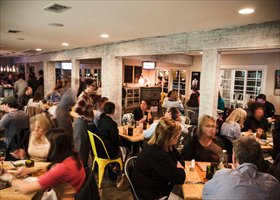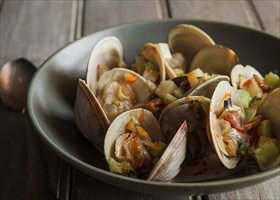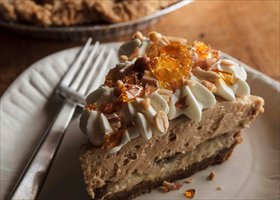Duo liven US Southern food

Dishes served at chefs Andrew Ticer and Michael Hudman's restaurant Hog & Hominy Photos: Courtesy of Hog & Hominy

Dishes served at chefs Andrew Ticer and Michael Hudman's restaurant Hog & Hominy Photos: Courtesy of Hog & Hominy

Dishes served at chefs Andrew Ticer and Michael Hudman's restaurant Hog & Hominy Photos: Courtesy of Hog & Hominy

Dishes served at chefs Andrew Ticer and Michael Hudman's restaurant Hog & Hominy Photos: Courtesy of Hog & Hominy
American chefs Andrew Ticer and Michael Hudman draw inspiration for their Southern cooking from their Italian heritage and their grandmothers' Sunday dinners, which they remember fondly in their first book Collard & Carbonara.
The childhood friends run two popular restaurants in Memphis, Andrew Michael Italian Kitchen and Hog & Hominy.
In the book, which they co-wrote with Nicholas Talarico, the duo recount their aspiration to become chefs while growing up in Memphis. They attended culinary school together and apprenticed under the same chef.
Ticer, 34, and Hudman, 33, spoke to Reuters about their grandmothers' Italian Sunday dinners and their twist on Southern food.
Q: What do want your readers to take away from this book?
A: Hudman: Andy and I want them to get a sense who we are and to get a sense of what motivates us and what pushes us every day. Besides the recipes in the book, we want people to know what makes us tick, our families and inspiration, the local farmers. We want them to really see the parallels we see between Italian food and Southern food.
Q: What are the parallels between the two types of cuisines?
A: Ticer: It's familiar flavors we grew up with from our grandmothers and eating them in a different way. It's the same approach we learn when we look at Italy. Italians cook what is in their regions. That is what we adopted with our philosophy.
Hudman: Both Italian and Southern foods are deeply rooted in peasant food. One of the dishes we do is the tortellini we grew up with and that our grandmothers make every New Year with black-eyed peas and collard greens. We took that idea that we grew up with and made a pasta with black-eyed pea tortellini filling and collard green with ham hock broth.
Q: How did your grandmothers instill your love for food?
A: Ticer: When we go to our Maw-Maw's (his name for his grandmother) house on Sundays, you went to Maw-Maw's for lunch ... The kids would stay there and that's where they'll hang out. I would fall in love with it and watch them make the pasta and talk in the kitchen. And that's where my love of food came about.
Hudman: The most thankful thing my grandmother has taught me was a pure love of food and a pure love of cooking. That comes off strongly in what Andy and I do. We really love food and we love cooking food. We have pictures of our grandmothers around the restaurant and in the kitchen.
Q: What is making Memphis an up-and-coming food destination?
A: Hudman: It has a lot of soul and grit to it. There are a lot of young chefs who are trying to do something awesome. Memphis is a town that gets really behind you and supports you. We have barbecues to lead the way. It has some of the best barbecues around ... There's an abundance of produce and we have these awesome farmers. The resurgence of the farmers has really done a lot.
Ticer: It's also part of the young professional movement that's going on in the city. We're together. We'll all friends and we're all supportive of one another.
Black-Eyed Pea Tortellini, Ham Hock Brodo & Collards
(Makes 4 servings)
* 8 oz (250 g) dried black-eyed peas,
soaked overnight and drained
* 3 slices bacon
* 1 yellow onion, diced
* 1 tablespoon roasted garlic
* Chicken stock
* 1 cup (8 oz/250 g) good-quality fresh
ricotta cheese
*1/4 cup (1 oz/30 g) dried bread
crumbs
* Pepper vinegar
* Basic pasta dough
* Semolina flour for dusting
* 2 cups (6 oz/185 g) Southern-
style collard greens
* 3 cups (24 fl oz/750 ml)
* Ham Hock Brodo
* Freshly grated cheese
Getting it just right
1. Drain the black-eyed peas and place in a large saucepan, and add water to cover by 2 inches.
2. Bring just to a boil over high heat, then reduce the heat to medium-low, and simmer until tender, about 45 minutes. In a large sauté pan, cook the bacon over medium-high heat until the fat is rendered, 2-4 minutes. Add the onion and sauté until caramelized, about 5 minutes. Stir in the black-eyed peas and roasted garlic and simmer for 10 minutes. Add the stock and stir to scrape up the browned bits on the pan bottom, then cook until the ingredients are nice and soft, about 10 minutes. In batches, transfer the contents of the pan to a blender and puree until smooth. Put in a bowl and mix well.
3. Make the pasta dough as directed. Roll it through a standard pasta machine on the number 6 setting. Working with 1 sheet of pasta at a time, and keeping the others covered with a damp kitchen towel as you work, use a 2-inch round cutter to cut the sheet into rounds. Spoon about 2 teaspoons of the filling into the center of each round, being careful not to add too much (Alternatively, spoon the filling into a pastry bag fitted with a 1/2-inch/12-mm plain tip and pipe the filling onto the rounds.)
4. Dampen a fingertip with water and run it along the edge of half of the round. Fold the other half of the round over the filling to make a half-moon. When all of the half-moons are formed, arrange them on the work surface with the rounded edge facing away from you. Place a finger of your nondominant hand in the center of a half-moon and use the fingers of your other hand to bring the two points together over your finger. Pinch the points together to seal the tortellini. Spread out the finished tortellini on a semolina-dusted baking sheet. Repeat with the remaining pasta rounds and filling. You need only half of the pasta shapes from the recipe; freeze the remaining for a future meal.
5. Bring a large pot of salted water to a boil. When the water is boiling, drop in the tortellini and cook until the pasta is al dente, about 8 minutes. Meanwhile, in a sauté pan, warm the greens and brodo with reserved meat over medium-low heat until warmed through. Drain the tortellini and add them to the pan. Toss until well coated.
6. Divide the tortellini in wide, shallow bowls, then ladle in the collards, ham hock meat, and brodo from the pan. Serve right away, passing additional pepper, vinegar and the Parmigiano-Reggiano at the table for diners to add to taste.